Contract and Negligence: Legal Analysis of Business Contracts
VerifiedAdded on 2020/01/16
|17
|6042
|167
Report
AI Summary
This report provides a comprehensive overview of contract and negligence law, crucial for business operations. It begins by defining the elements of a valid contract, including offer, acceptance, intention to create legal relations, consideration, capacity, and privity. The report then explores different contract forms (face-to-face, written, and distance selling) and various contract terms such as conditions, warranties, in-nominate terms, and exemption clauses. Task 1 focuses on the formation of contracts and the different types of contracts. Task 2 analyzes case studies to determine the presence of valid contracts. The report distinguishes between 'offer' and 'invitation to treat' and addresses the concept of past consideration. The report also clarifies that the parties must be bound in a contractual relationship directly or indirectly. Finally, the report distinguishes between Torts Law and Contract law, to be able to apply the principle of Negligence and doctrine of vicarious liability in different business relations.
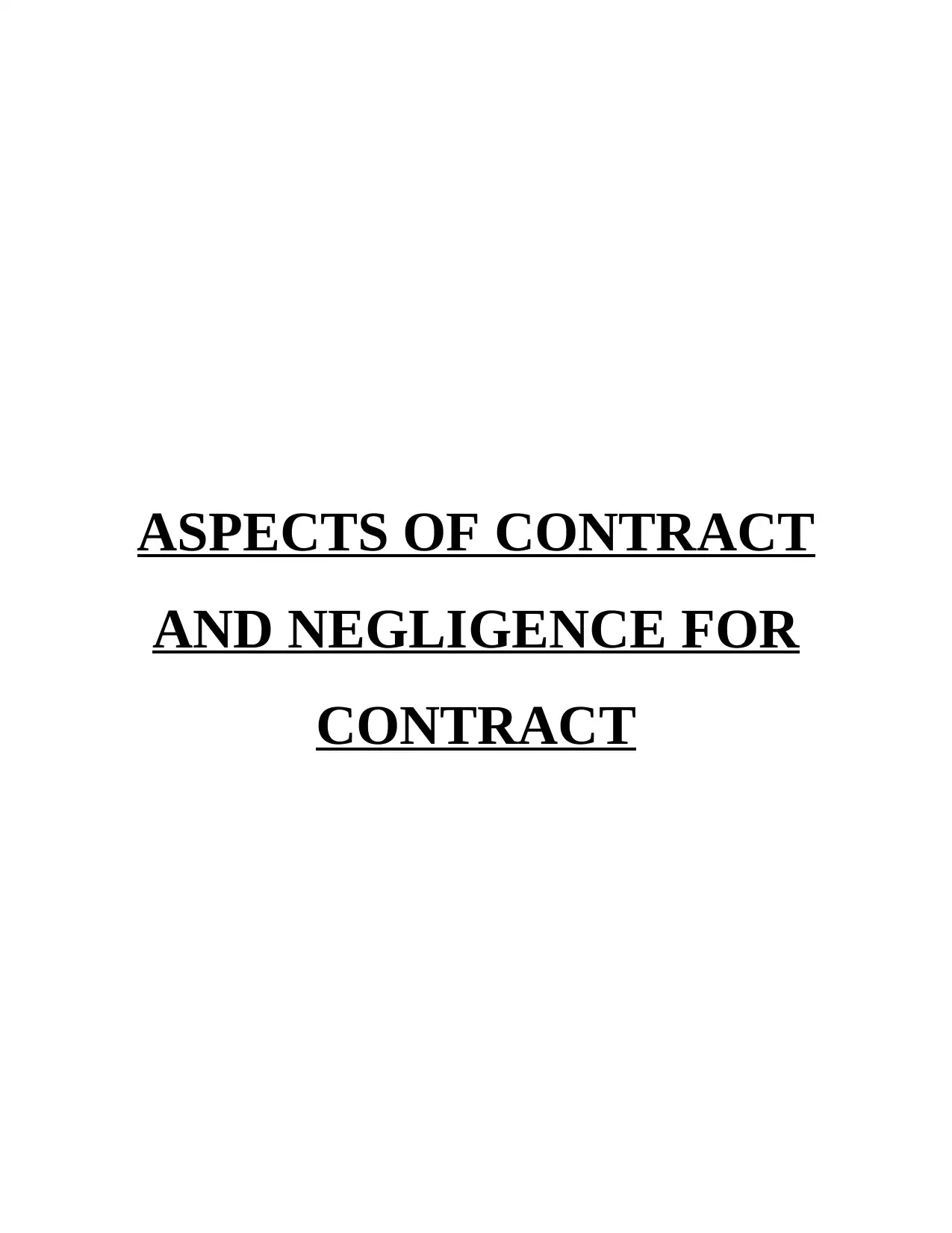
ASPECTS OF CONTRACT
AND NEGLIGENCE FOR
CONTRACT
AND NEGLIGENCE FOR
CONTRACT
Paraphrase This Document
Need a fresh take? Get an instant paraphrase of this document with our AI Paraphraser
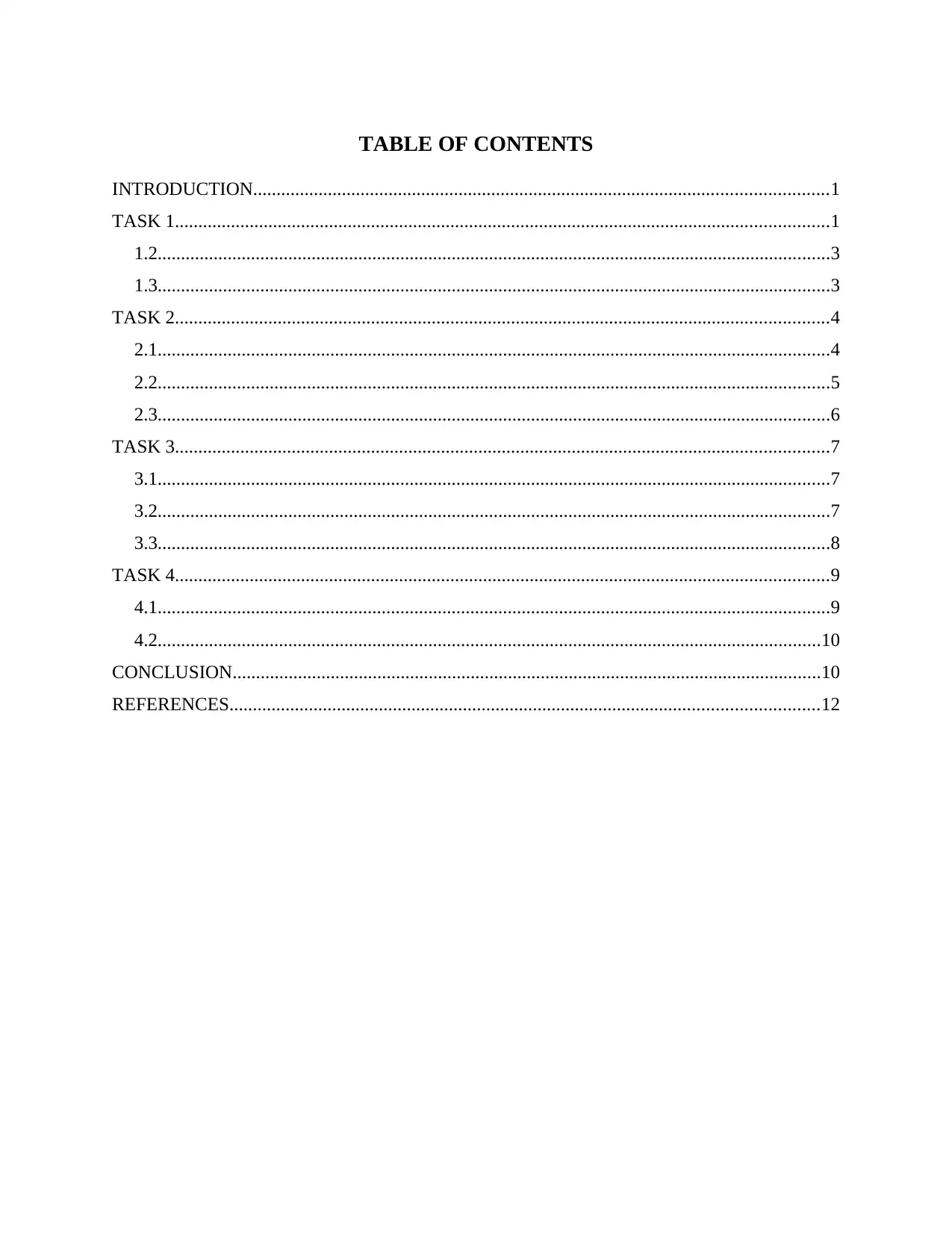
TABLE OF CONTENTS
INTRODUCTION...........................................................................................................................1
TASK 1............................................................................................................................................1
1.2................................................................................................................................................3
1.3................................................................................................................................................3
TASK 2............................................................................................................................................4
2.1................................................................................................................................................4
2.2................................................................................................................................................5
2.3................................................................................................................................................6
TASK 3............................................................................................................................................7
3.1................................................................................................................................................7
3.2................................................................................................................................................7
3.3................................................................................................................................................8
TASK 4............................................................................................................................................9
4.1................................................................................................................................................9
4.2..............................................................................................................................................10
CONCLUSION..............................................................................................................................10
REFERENCES..............................................................................................................................12
INTRODUCTION...........................................................................................................................1
TASK 1............................................................................................................................................1
1.2................................................................................................................................................3
1.3................................................................................................................................................3
TASK 2............................................................................................................................................4
2.1................................................................................................................................................4
2.2................................................................................................................................................5
2.3................................................................................................................................................6
TASK 3............................................................................................................................................7
3.1................................................................................................................................................7
3.2................................................................................................................................................7
3.3................................................................................................................................................8
TASK 4............................................................................................................................................9
4.1................................................................................................................................................9
4.2..............................................................................................................................................10
CONCLUSION..............................................................................................................................10
REFERENCES..............................................................................................................................12

⊘ This is a preview!⊘
Do you want full access?
Subscribe today to unlock all pages.

Trusted by 1+ million students worldwide
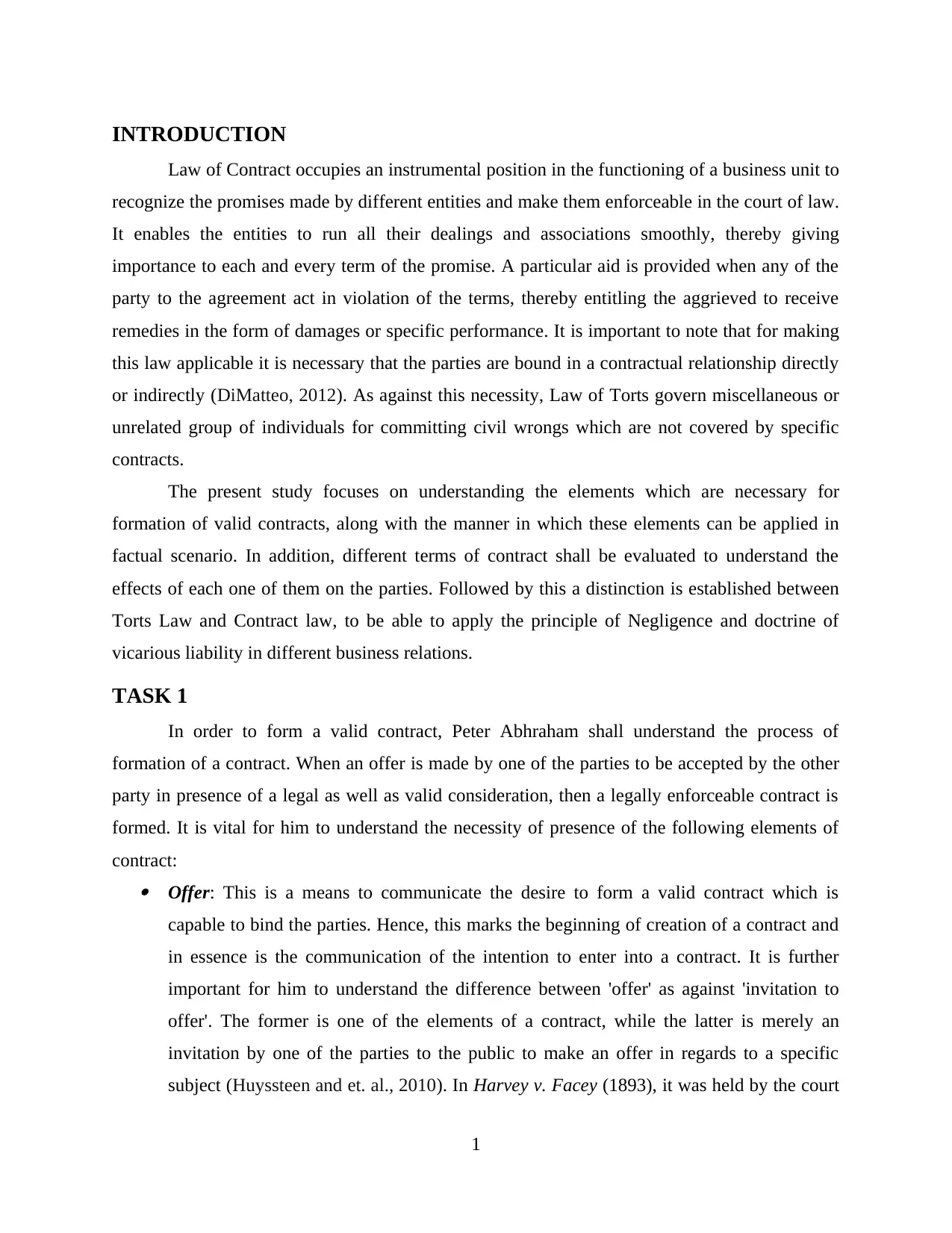
INTRODUCTION
Law of Contract occupies an instrumental position in the functioning of a business unit to
recognize the promises made by different entities and make them enforceable in the court of law.
It enables the entities to run all their dealings and associations smoothly, thereby giving
importance to each and every term of the promise. A particular aid is provided when any of the
party to the agreement act in violation of the terms, thereby entitling the aggrieved to receive
remedies in the form of damages or specific performance. It is important to note that for making
this law applicable it is necessary that the parties are bound in a contractual relationship directly
or indirectly (DiMatteo, 2012). As against this necessity, Law of Torts govern miscellaneous or
unrelated group of individuals for committing civil wrongs which are not covered by specific
contracts.
The present study focuses on understanding the elements which are necessary for
formation of valid contracts, along with the manner in which these elements can be applied in
factual scenario. In addition, different terms of contract shall be evaluated to understand the
effects of each one of them on the parties. Followed by this a distinction is established between
Torts Law and Contract law, to be able to apply the principle of Negligence and doctrine of
vicarious liability in different business relations.
TASK 1
In order to form a valid contract, Peter Abhraham shall understand the process of
formation of a contract. When an offer is made by one of the parties to be accepted by the other
party in presence of a legal as well as valid consideration, then a legally enforceable contract is
formed. It is vital for him to understand the necessity of presence of the following elements of
contract: Offer: This is a means to communicate the desire to form a valid contract which is
capable to bind the parties. Hence, this marks the beginning of creation of a contract and
in essence is the communication of the intention to enter into a contract. It is further
important for him to understand the difference between 'offer' as against 'invitation to
offer'. The former is one of the elements of a contract, while the latter is merely an
invitation by one of the parties to the public to make an offer in regards to a specific
subject (Huyssteen and et. al., 2010). In Harvey v. Facey (1893), it was held by the court
1
Law of Contract occupies an instrumental position in the functioning of a business unit to
recognize the promises made by different entities and make them enforceable in the court of law.
It enables the entities to run all their dealings and associations smoothly, thereby giving
importance to each and every term of the promise. A particular aid is provided when any of the
party to the agreement act in violation of the terms, thereby entitling the aggrieved to receive
remedies in the form of damages or specific performance. It is important to note that for making
this law applicable it is necessary that the parties are bound in a contractual relationship directly
or indirectly (DiMatteo, 2012). As against this necessity, Law of Torts govern miscellaneous or
unrelated group of individuals for committing civil wrongs which are not covered by specific
contracts.
The present study focuses on understanding the elements which are necessary for
formation of valid contracts, along with the manner in which these elements can be applied in
factual scenario. In addition, different terms of contract shall be evaluated to understand the
effects of each one of them on the parties. Followed by this a distinction is established between
Torts Law and Contract law, to be able to apply the principle of Negligence and doctrine of
vicarious liability in different business relations.
TASK 1
In order to form a valid contract, Peter Abhraham shall understand the process of
formation of a contract. When an offer is made by one of the parties to be accepted by the other
party in presence of a legal as well as valid consideration, then a legally enforceable contract is
formed. It is vital for him to understand the necessity of presence of the following elements of
contract: Offer: This is a means to communicate the desire to form a valid contract which is
capable to bind the parties. Hence, this marks the beginning of creation of a contract and
in essence is the communication of the intention to enter into a contract. It is further
important for him to understand the difference between 'offer' as against 'invitation to
offer'. The former is one of the elements of a contract, while the latter is merely an
invitation by one of the parties to the public to make an offer in regards to a specific
subject (Huyssteen and et. al., 2010). In Harvey v. Facey (1893), it was held by the court
1
Paraphrase This Document
Need a fresh take? Get an instant paraphrase of this document with our AI Paraphraser
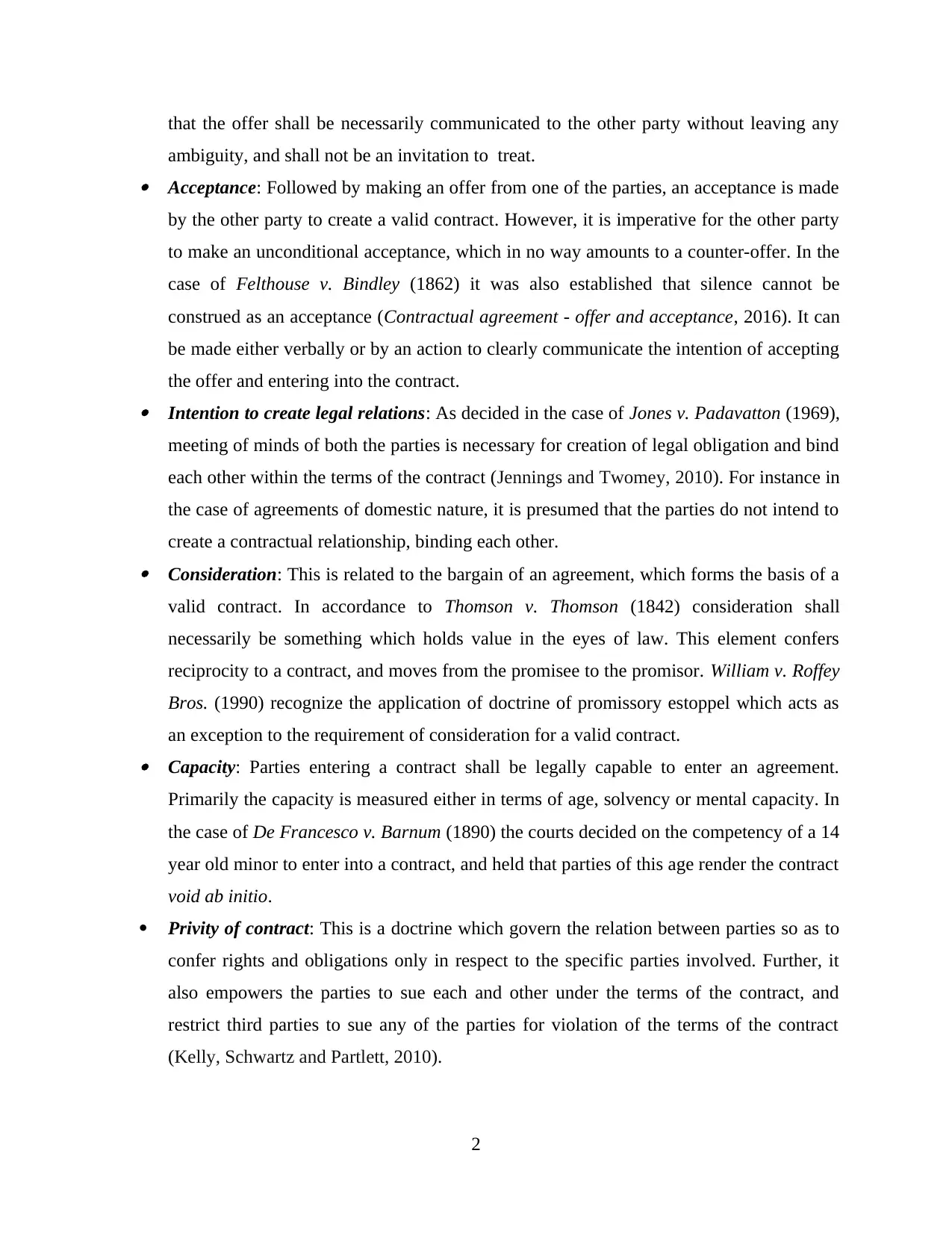
that the offer shall be necessarily communicated to the other party without leaving any
ambiguity, and shall not be an invitation to treat. Acceptance: Followed by making an offer from one of the parties, an acceptance is made
by the other party to create a valid contract. However, it is imperative for the other party
to make an unconditional acceptance, which in no way amounts to a counter-offer. In the
case of Felthouse v. Bindley (1862) it was also established that silence cannot be
construed as an acceptance (Contractual agreement - offer and acceptance, 2016). It can
be made either verbally or by an action to clearly communicate the intention of accepting
the offer and entering into the contract. Intention to create legal relations: As decided in the case of Jones v. Padavatton (1969),
meeting of minds of both the parties is necessary for creation of legal obligation and bind
each other within the terms of the contract (Jennings and Twomey, 2010). For instance in
the case of agreements of domestic nature, it is presumed that the parties do not intend to
create a contractual relationship, binding each other. Consideration: This is related to the bargain of an agreement, which forms the basis of a
valid contract. In accordance to Thomson v. Thomson (1842) consideration shall
necessarily be something which holds value in the eyes of law. This element confers
reciprocity to a contract, and moves from the promisee to the promisor. William v. Roffey
Bros. (1990) recognize the application of doctrine of promissory estoppel which acts as
an exception to the requirement of consideration for a valid contract. Capacity: Parties entering a contract shall be legally capable to enter an agreement.
Primarily the capacity is measured either in terms of age, solvency or mental capacity. In
the case of De Francesco v. Barnum (1890) the courts decided on the competency of a 14
year old minor to enter into a contract, and held that parties of this age render the contract
void ab initio.
Privity of contract: This is a doctrine which govern the relation between parties so as to
confer rights and obligations only in respect to the specific parties involved. Further, it
also empowers the parties to sue each and other under the terms of the contract, and
restrict third parties to sue any of the parties for violation of the terms of the contract
(Kelly, Schwartz and Partlett, 2010).
2
ambiguity, and shall not be an invitation to treat. Acceptance: Followed by making an offer from one of the parties, an acceptance is made
by the other party to create a valid contract. However, it is imperative for the other party
to make an unconditional acceptance, which in no way amounts to a counter-offer. In the
case of Felthouse v. Bindley (1862) it was also established that silence cannot be
construed as an acceptance (Contractual agreement - offer and acceptance, 2016). It can
be made either verbally or by an action to clearly communicate the intention of accepting
the offer and entering into the contract. Intention to create legal relations: As decided in the case of Jones v. Padavatton (1969),
meeting of minds of both the parties is necessary for creation of legal obligation and bind
each other within the terms of the contract (Jennings and Twomey, 2010). For instance in
the case of agreements of domestic nature, it is presumed that the parties do not intend to
create a contractual relationship, binding each other. Consideration: This is related to the bargain of an agreement, which forms the basis of a
valid contract. In accordance to Thomson v. Thomson (1842) consideration shall
necessarily be something which holds value in the eyes of law. This element confers
reciprocity to a contract, and moves from the promisee to the promisor. William v. Roffey
Bros. (1990) recognize the application of doctrine of promissory estoppel which acts as
an exception to the requirement of consideration for a valid contract. Capacity: Parties entering a contract shall be legally capable to enter an agreement.
Primarily the capacity is measured either in terms of age, solvency or mental capacity. In
the case of De Francesco v. Barnum (1890) the courts decided on the competency of a 14
year old minor to enter into a contract, and held that parties of this age render the contract
void ab initio.
Privity of contract: This is a doctrine which govern the relation between parties so as to
confer rights and obligations only in respect to the specific parties involved. Further, it
also empowers the parties to sue each and other under the terms of the contract, and
restrict third parties to sue any of the parties for violation of the terms of the contract
(Kelly, Schwartz and Partlett, 2010).
2
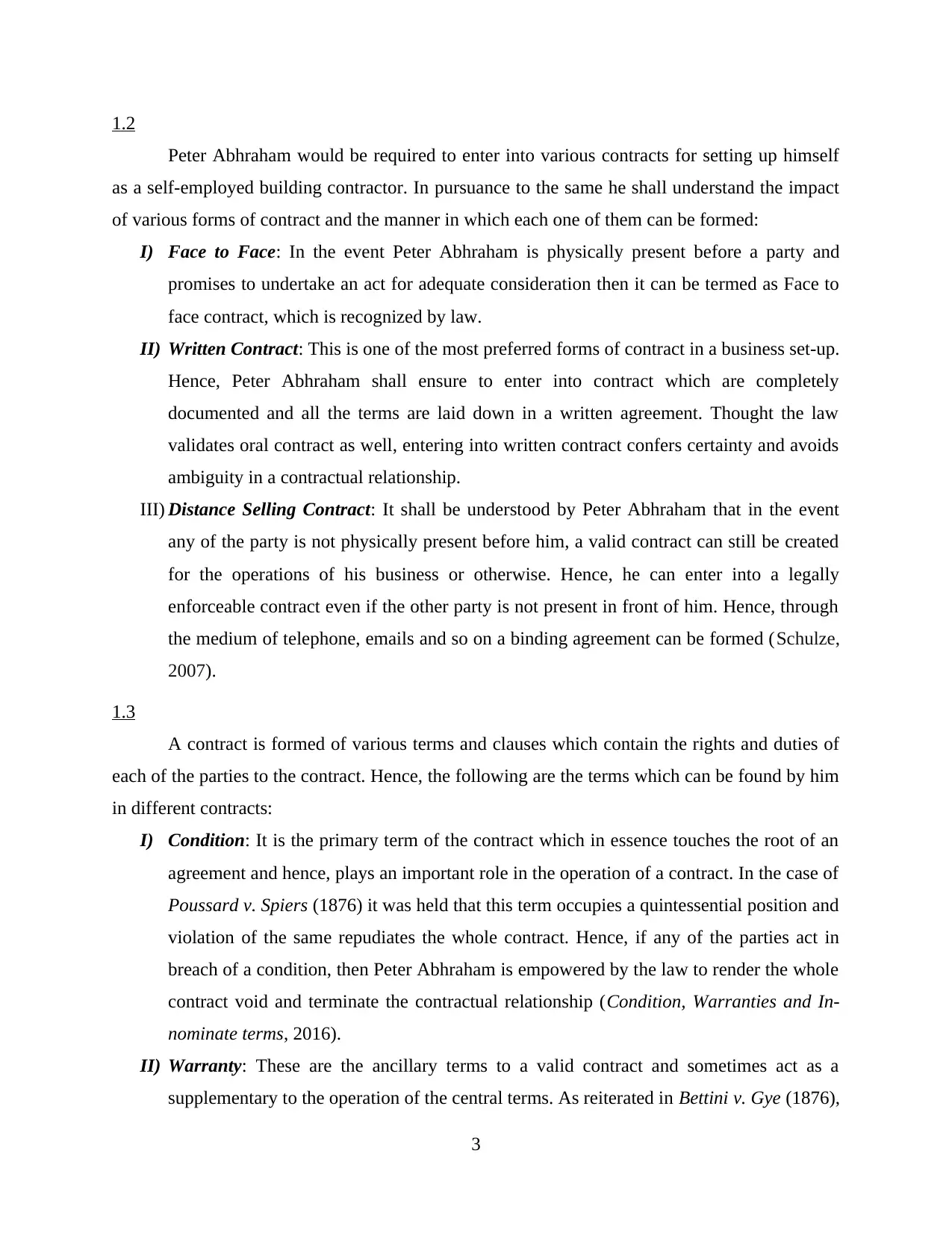
1.2
Peter Abhraham would be required to enter into various contracts for setting up himself
as a self-employed building contractor. In pursuance to the same he shall understand the impact
of various forms of contract and the manner in which each one of them can be formed:
I) Face to Face: In the event Peter Abhraham is physically present before a party and
promises to undertake an act for adequate consideration then it can be termed as Face to
face contract, which is recognized by law.
II) Written Contract: This is one of the most preferred forms of contract in a business set-up.
Hence, Peter Abhraham shall ensure to enter into contract which are completely
documented and all the terms are laid down in a written agreement. Thought the law
validates oral contract as well, entering into written contract confers certainty and avoids
ambiguity in a contractual relationship.
III) Distance Selling Contract: It shall be understood by Peter Abhraham that in the event
any of the party is not physically present before him, a valid contract can still be created
for the operations of his business or otherwise. Hence, he can enter into a legally
enforceable contract even if the other party is not present in front of him. Hence, through
the medium of telephone, emails and so on a binding agreement can be formed (Schulze,
2007).
1.3
A contract is formed of various terms and clauses which contain the rights and duties of
each of the parties to the contract. Hence, the following are the terms which can be found by him
in different contracts:
I) Condition: It is the primary term of the contract which in essence touches the root of an
agreement and hence, plays an important role in the operation of a contract. In the case of
Poussard v. Spiers (1876) it was held that this term occupies a quintessential position and
violation of the same repudiates the whole contract. Hence, if any of the parties act in
breach of a condition, then Peter Abhraham is empowered by the law to render the whole
contract void and terminate the contractual relationship (Condition, Warranties and In-
nominate terms, 2016).
II) Warranty: These are the ancillary terms to a valid contract and sometimes act as a
supplementary to the operation of the central terms. As reiterated in Bettini v. Gye (1876),
3
Peter Abhraham would be required to enter into various contracts for setting up himself
as a self-employed building contractor. In pursuance to the same he shall understand the impact
of various forms of contract and the manner in which each one of them can be formed:
I) Face to Face: In the event Peter Abhraham is physically present before a party and
promises to undertake an act for adequate consideration then it can be termed as Face to
face contract, which is recognized by law.
II) Written Contract: This is one of the most preferred forms of contract in a business set-up.
Hence, Peter Abhraham shall ensure to enter into contract which are completely
documented and all the terms are laid down in a written agreement. Thought the law
validates oral contract as well, entering into written contract confers certainty and avoids
ambiguity in a contractual relationship.
III) Distance Selling Contract: It shall be understood by Peter Abhraham that in the event
any of the party is not physically present before him, a valid contract can still be created
for the operations of his business or otherwise. Hence, he can enter into a legally
enforceable contract even if the other party is not present in front of him. Hence, through
the medium of telephone, emails and so on a binding agreement can be formed (Schulze,
2007).
1.3
A contract is formed of various terms and clauses which contain the rights and duties of
each of the parties to the contract. Hence, the following are the terms which can be found by him
in different contracts:
I) Condition: It is the primary term of the contract which in essence touches the root of an
agreement and hence, plays an important role in the operation of a contract. In the case of
Poussard v. Spiers (1876) it was held that this term occupies a quintessential position and
violation of the same repudiates the whole contract. Hence, if any of the parties act in
breach of a condition, then Peter Abhraham is empowered by the law to render the whole
contract void and terminate the contractual relationship (Condition, Warranties and In-
nominate terms, 2016).
II) Warranty: These are the ancillary terms to a valid contract and sometimes act as a
supplementary to the operation of the central terms. As reiterated in Bettini v. Gye (1876),
3
⊘ This is a preview!⊘
Do you want full access?
Subscribe today to unlock all pages.

Trusted by 1+ million students worldwide
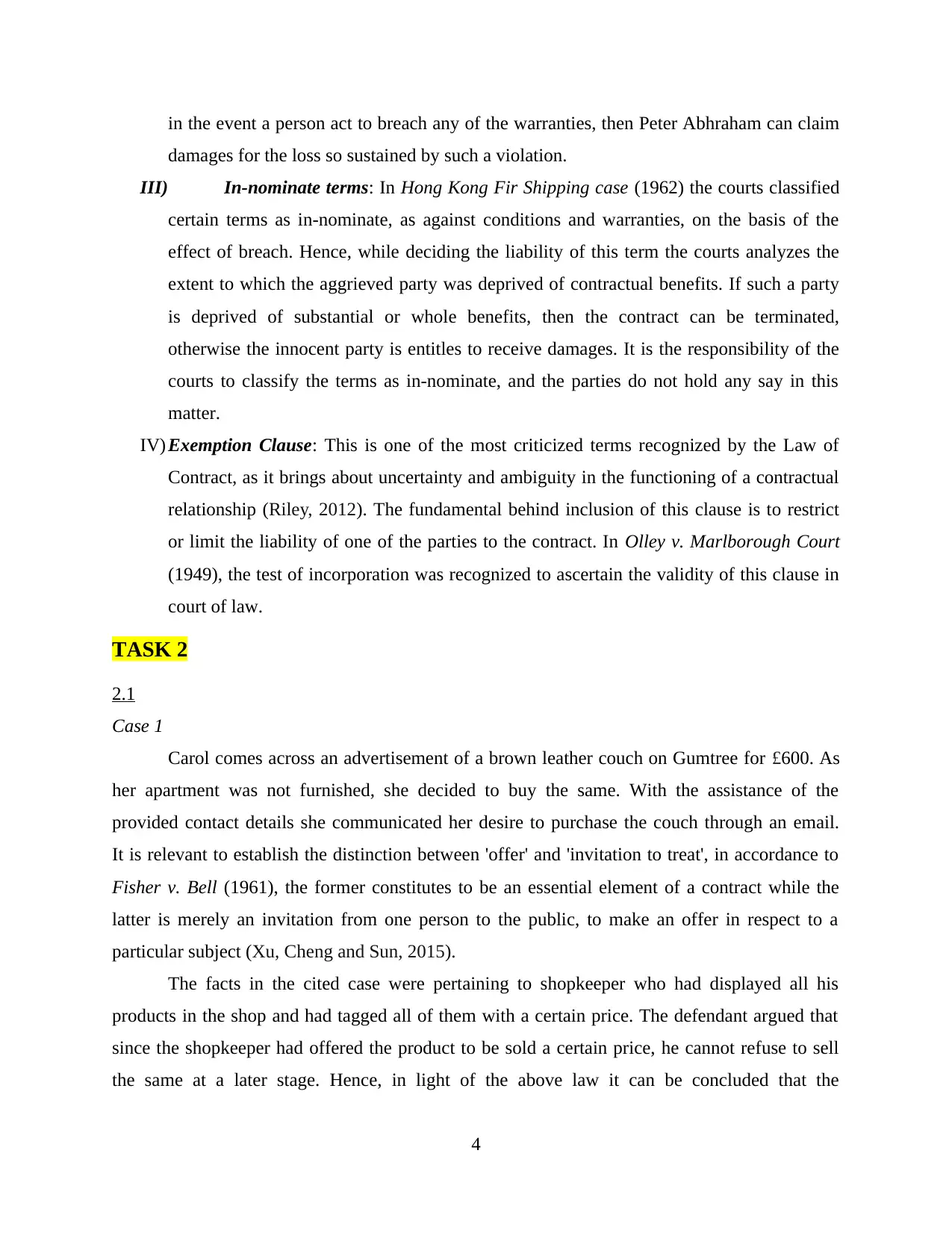
in the event a person act to breach any of the warranties, then Peter Abhraham can claim
damages for the loss so sustained by such a violation.
III) In-nominate terms: In Hong Kong Fir Shipping case (1962) the courts classified
certain terms as in-nominate, as against conditions and warranties, on the basis of the
effect of breach. Hence, while deciding the liability of this term the courts analyzes the
extent to which the aggrieved party was deprived of contractual benefits. If such a party
is deprived of substantial or whole benefits, then the contract can be terminated,
otherwise the innocent party is entitles to receive damages. It is the responsibility of the
courts to classify the terms as in-nominate, and the parties do not hold any say in this
matter.
IV) Exemption Clause: This is one of the most criticized terms recognized by the Law of
Contract, as it brings about uncertainty and ambiguity in the functioning of a contractual
relationship (Riley, 2012). The fundamental behind inclusion of this clause is to restrict
or limit the liability of one of the parties to the contract. In Olley v. Marlborough Court
(1949), the test of incorporation was recognized to ascertain the validity of this clause in
court of law.
TASK 2
2.1
Case 1
Carol comes across an advertisement of a brown leather couch on Gumtree for £600. As
her apartment was not furnished, she decided to buy the same. With the assistance of the
provided contact details she communicated her desire to purchase the couch through an email.
It is relevant to establish the distinction between 'offer' and 'invitation to treat', in accordance to
Fisher v. Bell (1961), the former constitutes to be an essential element of a contract while the
latter is merely an invitation from one person to the public, to make an offer in respect to a
particular subject (Xu, Cheng and Sun, 2015).
The facts in the cited case were pertaining to shopkeeper who had displayed all his
products in the shop and had tagged all of them with a certain price. The defendant argued that
since the shopkeeper had offered the product to be sold a certain price, he cannot refuse to sell
the same at a later stage. Hence, in light of the above law it can be concluded that the
4
damages for the loss so sustained by such a violation.
III) In-nominate terms: In Hong Kong Fir Shipping case (1962) the courts classified
certain terms as in-nominate, as against conditions and warranties, on the basis of the
effect of breach. Hence, while deciding the liability of this term the courts analyzes the
extent to which the aggrieved party was deprived of contractual benefits. If such a party
is deprived of substantial or whole benefits, then the contract can be terminated,
otherwise the innocent party is entitles to receive damages. It is the responsibility of the
courts to classify the terms as in-nominate, and the parties do not hold any say in this
matter.
IV) Exemption Clause: This is one of the most criticized terms recognized by the Law of
Contract, as it brings about uncertainty and ambiguity in the functioning of a contractual
relationship (Riley, 2012). The fundamental behind inclusion of this clause is to restrict
or limit the liability of one of the parties to the contract. In Olley v. Marlborough Court
(1949), the test of incorporation was recognized to ascertain the validity of this clause in
court of law.
TASK 2
2.1
Case 1
Carol comes across an advertisement of a brown leather couch on Gumtree for £600. As
her apartment was not furnished, she decided to buy the same. With the assistance of the
provided contact details she communicated her desire to purchase the couch through an email.
It is relevant to establish the distinction between 'offer' and 'invitation to treat', in accordance to
Fisher v. Bell (1961), the former constitutes to be an essential element of a contract while the
latter is merely an invitation from one person to the public, to make an offer in respect to a
particular subject (Xu, Cheng and Sun, 2015).
The facts in the cited case were pertaining to shopkeeper who had displayed all his
products in the shop and had tagged all of them with a certain price. The defendant argued that
since the shopkeeper had offered the product to be sold a certain price, he cannot refuse to sell
the same at a later stage. Hence, in light of the above law it can be concluded that the
4
Paraphrase This Document
Need a fresh take? Get an instant paraphrase of this document with our AI Paraphraser
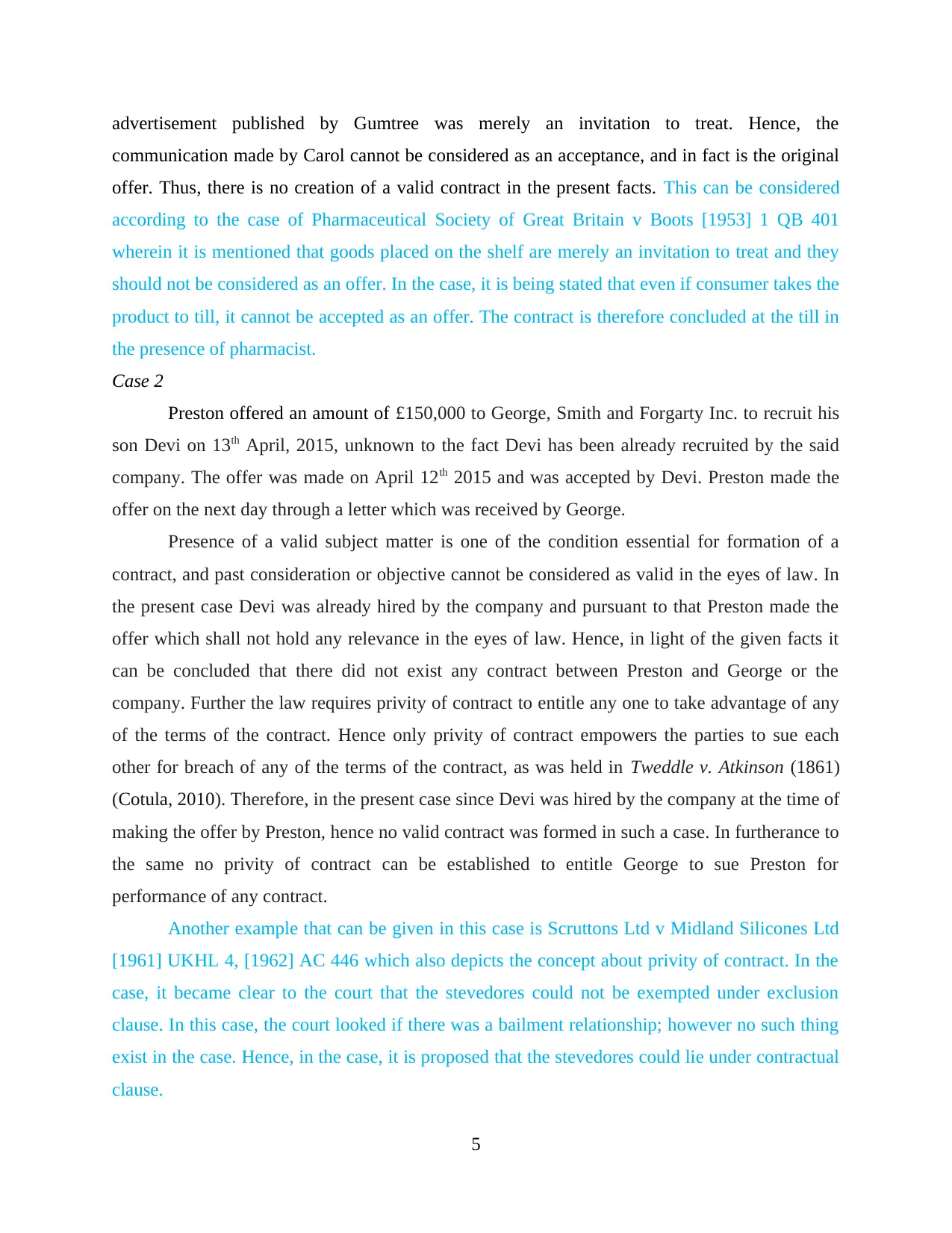
advertisement published by Gumtree was merely an invitation to treat. Hence, the
communication made by Carol cannot be considered as an acceptance, and in fact is the original
offer. Thus, there is no creation of a valid contract in the present facts. This can be considered
according to the case of Pharmaceutical Society of Great Britain v Boots [1953] 1 QB 401
wherein it is mentioned that goods placed on the shelf are merely an invitation to treat and they
should not be considered as an offer. In the case, it is being stated that even if consumer takes the
product to till, it cannot be accepted as an offer. The contract is therefore concluded at the till in
the presence of pharmacist.
Case 2
Preston offered an amount of £150,000 to George, Smith and Forgarty Inc. to recruit his
son Devi on 13th April, 2015, unknown to the fact Devi has been already recruited by the said
company. The offer was made on April 12th 2015 and was accepted by Devi. Preston made the
offer on the next day through a letter which was received by George.
Presence of a valid subject matter is one of the condition essential for formation of a
contract, and past consideration or objective cannot be considered as valid in the eyes of law. In
the present case Devi was already hired by the company and pursuant to that Preston made the
offer which shall not hold any relevance in the eyes of law. Hence, in light of the given facts it
can be concluded that there did not exist any contract between Preston and George or the
company. Further the law requires privity of contract to entitle any one to take advantage of any
of the terms of the contract. Hence only privity of contract empowers the parties to sue each
other for breach of any of the terms of the contract, as was held in Tweddle v. Atkinson (1861)
(Cotula, 2010). Therefore, in the present case since Devi was hired by the company at the time of
making the offer by Preston, hence no valid contract was formed in such a case. In furtherance to
the same no privity of contract can be established to entitle George to sue Preston for
performance of any contract.
Another example that can be given in this case is Scruttons Ltd v Midland Silicones Ltd
[1961] UKHL 4, [1962] AC 446 which also depicts the concept about privity of contract. In the
case, it became clear to the court that the stevedores could not be exempted under exclusion
clause. In this case, the court looked if there was a bailment relationship; however no such thing
exist in the case. Hence, in the case, it is proposed that the stevedores could lie under contractual
clause.
5
communication made by Carol cannot be considered as an acceptance, and in fact is the original
offer. Thus, there is no creation of a valid contract in the present facts. This can be considered
according to the case of Pharmaceutical Society of Great Britain v Boots [1953] 1 QB 401
wherein it is mentioned that goods placed on the shelf are merely an invitation to treat and they
should not be considered as an offer. In the case, it is being stated that even if consumer takes the
product to till, it cannot be accepted as an offer. The contract is therefore concluded at the till in
the presence of pharmacist.
Case 2
Preston offered an amount of £150,000 to George, Smith and Forgarty Inc. to recruit his
son Devi on 13th April, 2015, unknown to the fact Devi has been already recruited by the said
company. The offer was made on April 12th 2015 and was accepted by Devi. Preston made the
offer on the next day through a letter which was received by George.
Presence of a valid subject matter is one of the condition essential for formation of a
contract, and past consideration or objective cannot be considered as valid in the eyes of law. In
the present case Devi was already hired by the company and pursuant to that Preston made the
offer which shall not hold any relevance in the eyes of law. Hence, in light of the given facts it
can be concluded that there did not exist any contract between Preston and George or the
company. Further the law requires privity of contract to entitle any one to take advantage of any
of the terms of the contract. Hence only privity of contract empowers the parties to sue each
other for breach of any of the terms of the contract, as was held in Tweddle v. Atkinson (1861)
(Cotula, 2010). Therefore, in the present case since Devi was hired by the company at the time of
making the offer by Preston, hence no valid contract was formed in such a case. In furtherance to
the same no privity of contract can be established to entitle George to sue Preston for
performance of any contract.
Another example that can be given in this case is Scruttons Ltd v Midland Silicones Ltd
[1961] UKHL 4, [1962] AC 446 which also depicts the concept about privity of contract. In the
case, it became clear to the court that the stevedores could not be exempted under exclusion
clause. In this case, the court looked if there was a bailment relationship; however no such thing
exist in the case. Hence, in the case, it is proposed that the stevedores could lie under contractual
clause.
5
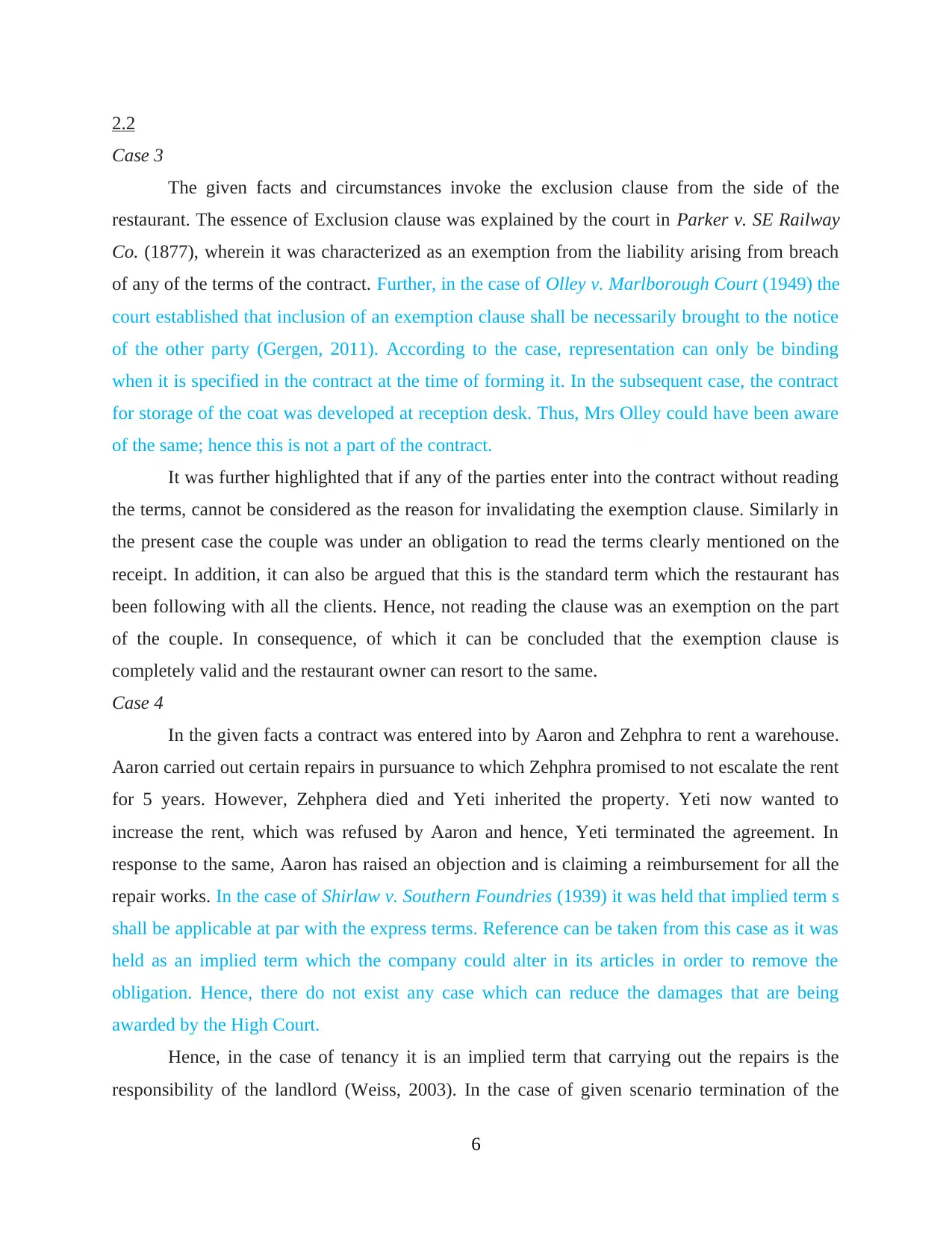
2.2
Case 3
The given facts and circumstances invoke the exclusion clause from the side of the
restaurant. The essence of Exclusion clause was explained by the court in Parker v. SE Railway
Co. (1877), wherein it was characterized as an exemption from the liability arising from breach
of any of the terms of the contract. Further, in the case of Olley v. Marlborough Court (1949) the
court established that inclusion of an exemption clause shall be necessarily brought to the notice
of the other party (Gergen, 2011). According to the case, representation can only be binding
when it is specified in the contract at the time of forming it. In the subsequent case, the contract
for storage of the coat was developed at reception desk. Thus, Mrs Olley could have been aware
of the same; hence this is not a part of the contract.
It was further highlighted that if any of the parties enter into the contract without reading
the terms, cannot be considered as the reason for invalidating the exemption clause. Similarly in
the present case the couple was under an obligation to read the terms clearly mentioned on the
receipt. In addition, it can also be argued that this is the standard term which the restaurant has
been following with all the clients. Hence, not reading the clause was an exemption on the part
of the couple. In consequence, of which it can be concluded that the exemption clause is
completely valid and the restaurant owner can resort to the same.
Case 4
In the given facts a contract was entered into by Aaron and Zehphra to rent a warehouse.
Aaron carried out certain repairs in pursuance to which Zehphra promised to not escalate the rent
for 5 years. However, Zehphera died and Yeti inherited the property. Yeti now wanted to
increase the rent, which was refused by Aaron and hence, Yeti terminated the agreement. In
response to the same, Aaron has raised an objection and is claiming a reimbursement for all the
repair works. In the case of Shirlaw v. Southern Foundries (1939) it was held that implied term s
shall be applicable at par with the express terms. Reference can be taken from this case as it was
held as an implied term which the company could alter in its articles in order to remove the
obligation. Hence, there do not exist any case which can reduce the damages that are being
awarded by the High Court.
Hence, in the case of tenancy it is an implied term that carrying out the repairs is the
responsibility of the landlord (Weiss, 2003). In the case of given scenario termination of the
6
Case 3
The given facts and circumstances invoke the exclusion clause from the side of the
restaurant. The essence of Exclusion clause was explained by the court in Parker v. SE Railway
Co. (1877), wherein it was characterized as an exemption from the liability arising from breach
of any of the terms of the contract. Further, in the case of Olley v. Marlborough Court (1949) the
court established that inclusion of an exemption clause shall be necessarily brought to the notice
of the other party (Gergen, 2011). According to the case, representation can only be binding
when it is specified in the contract at the time of forming it. In the subsequent case, the contract
for storage of the coat was developed at reception desk. Thus, Mrs Olley could have been aware
of the same; hence this is not a part of the contract.
It was further highlighted that if any of the parties enter into the contract without reading
the terms, cannot be considered as the reason for invalidating the exemption clause. Similarly in
the present case the couple was under an obligation to read the terms clearly mentioned on the
receipt. In addition, it can also be argued that this is the standard term which the restaurant has
been following with all the clients. Hence, not reading the clause was an exemption on the part
of the couple. In consequence, of which it can be concluded that the exemption clause is
completely valid and the restaurant owner can resort to the same.
Case 4
In the given facts a contract was entered into by Aaron and Zehphra to rent a warehouse.
Aaron carried out certain repairs in pursuance to which Zehphra promised to not escalate the rent
for 5 years. However, Zehphera died and Yeti inherited the property. Yeti now wanted to
increase the rent, which was refused by Aaron and hence, Yeti terminated the agreement. In
response to the same, Aaron has raised an objection and is claiming a reimbursement for all the
repair works. In the case of Shirlaw v. Southern Foundries (1939) it was held that implied term s
shall be applicable at par with the express terms. Reference can be taken from this case as it was
held as an implied term which the company could alter in its articles in order to remove the
obligation. Hence, there do not exist any case which can reduce the damages that are being
awarded by the High Court.
Hence, in the case of tenancy it is an implied term that carrying out the repairs is the
responsibility of the landlord (Weiss, 2003). In the case of given scenario termination of the
6
⊘ This is a preview!⊘
Do you want full access?
Subscribe today to unlock all pages.

Trusted by 1+ million students worldwide
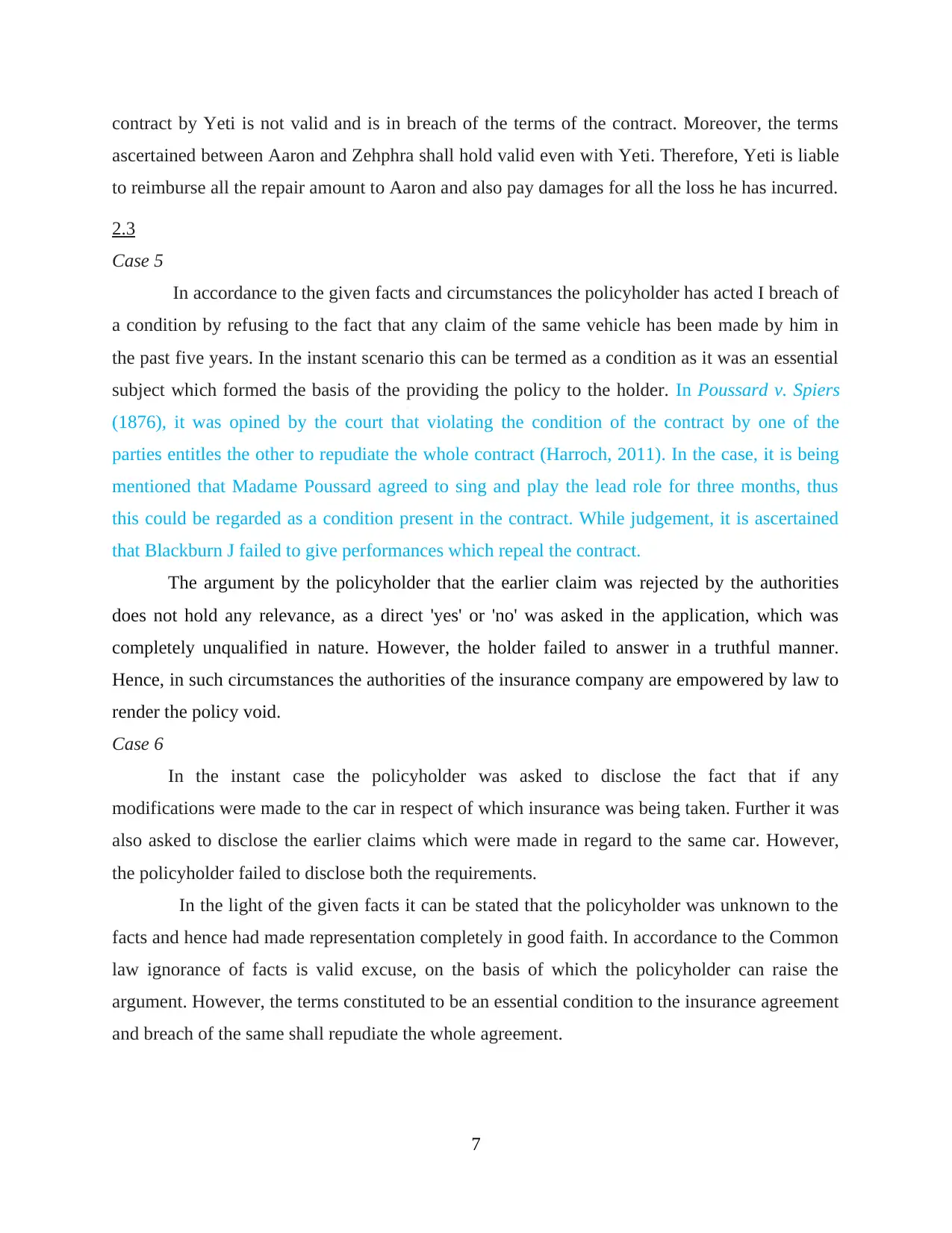
contract by Yeti is not valid and is in breach of the terms of the contract. Moreover, the terms
ascertained between Aaron and Zehphra shall hold valid even with Yeti. Therefore, Yeti is liable
to reimburse all the repair amount to Aaron and also pay damages for all the loss he has incurred.
2.3
Case 5
In accordance to the given facts and circumstances the policyholder has acted I breach of
a condition by refusing to the fact that any claim of the same vehicle has been made by him in
the past five years. In the instant scenario this can be termed as a condition as it was an essential
subject which formed the basis of the providing the policy to the holder. In Poussard v. Spiers
(1876), it was opined by the court that violating the condition of the contract by one of the
parties entitles the other to repudiate the whole contract (Harroch, 2011). In the case, it is being
mentioned that Madame Poussard agreed to sing and play the lead role for three months, thus
this could be regarded as a condition present in the contract. While judgement, it is ascertained
that Blackburn J failed to give performances which repeal the contract.
The argument by the policyholder that the earlier claim was rejected by the authorities
does not hold any relevance, as a direct 'yes' or 'no' was asked in the application, which was
completely unqualified in nature. However, the holder failed to answer in a truthful manner.
Hence, in such circumstances the authorities of the insurance company are empowered by law to
render the policy void.
Case 6
In the instant case the policyholder was asked to disclose the fact that if any
modifications were made to the car in respect of which insurance was being taken. Further it was
also asked to disclose the earlier claims which were made in regard to the same car. However,
the policyholder failed to disclose both the requirements.
In the light of the given facts it can be stated that the policyholder was unknown to the
facts and hence had made representation completely in good faith. In accordance to the Common
law ignorance of facts is valid excuse, on the basis of which the policyholder can raise the
argument. However, the terms constituted to be an essential condition to the insurance agreement
and breach of the same shall repudiate the whole agreement.
7
ascertained between Aaron and Zehphra shall hold valid even with Yeti. Therefore, Yeti is liable
to reimburse all the repair amount to Aaron and also pay damages for all the loss he has incurred.
2.3
Case 5
In accordance to the given facts and circumstances the policyholder has acted I breach of
a condition by refusing to the fact that any claim of the same vehicle has been made by him in
the past five years. In the instant scenario this can be termed as a condition as it was an essential
subject which formed the basis of the providing the policy to the holder. In Poussard v. Spiers
(1876), it was opined by the court that violating the condition of the contract by one of the
parties entitles the other to repudiate the whole contract (Harroch, 2011). In the case, it is being
mentioned that Madame Poussard agreed to sing and play the lead role for three months, thus
this could be regarded as a condition present in the contract. While judgement, it is ascertained
that Blackburn J failed to give performances which repeal the contract.
The argument by the policyholder that the earlier claim was rejected by the authorities
does not hold any relevance, as a direct 'yes' or 'no' was asked in the application, which was
completely unqualified in nature. However, the holder failed to answer in a truthful manner.
Hence, in such circumstances the authorities of the insurance company are empowered by law to
render the policy void.
Case 6
In the instant case the policyholder was asked to disclose the fact that if any
modifications were made to the car in respect of which insurance was being taken. Further it was
also asked to disclose the earlier claims which were made in regard to the same car. However,
the policyholder failed to disclose both the requirements.
In the light of the given facts it can be stated that the policyholder was unknown to the
facts and hence had made representation completely in good faith. In accordance to the Common
law ignorance of facts is valid excuse, on the basis of which the policyholder can raise the
argument. However, the terms constituted to be an essential condition to the insurance agreement
and breach of the same shall repudiate the whole agreement.
7
Paraphrase This Document
Need a fresh take? Get an instant paraphrase of this document with our AI Paraphraser
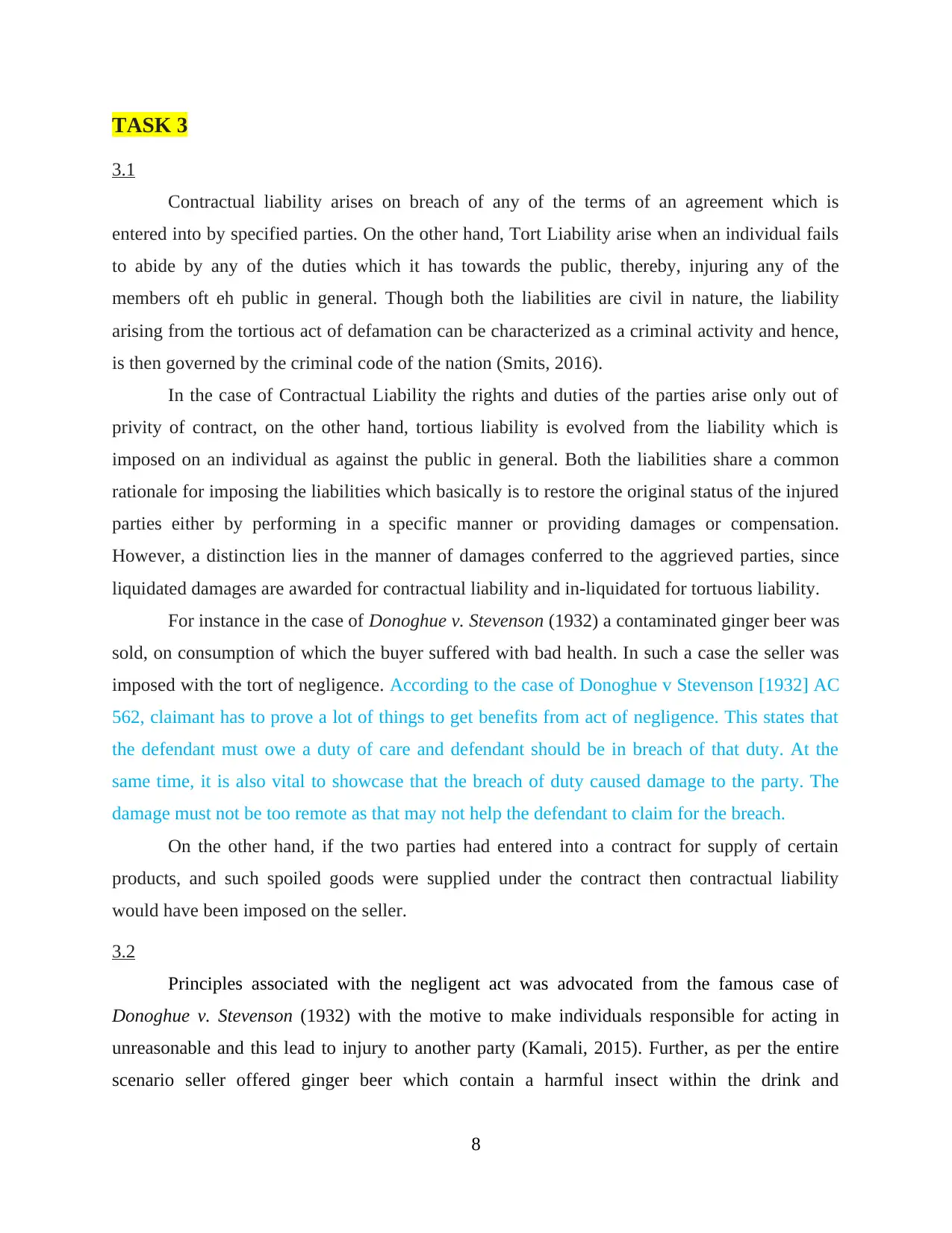
TASK 3
3.1
Contractual liability arises on breach of any of the terms of an agreement which is
entered into by specified parties. On the other hand, Tort Liability arise when an individual fails
to abide by any of the duties which it has towards the public, thereby, injuring any of the
members oft eh public in general. Though both the liabilities are civil in nature, the liability
arising from the tortious act of defamation can be characterized as a criminal activity and hence,
is then governed by the criminal code of the nation (Smits, 2016).
In the case of Contractual Liability the rights and duties of the parties arise only out of
privity of contract, on the other hand, tortious liability is evolved from the liability which is
imposed on an individual as against the public in general. Both the liabilities share a common
rationale for imposing the liabilities which basically is to restore the original status of the injured
parties either by performing in a specific manner or providing damages or compensation.
However, a distinction lies in the manner of damages conferred to the aggrieved parties, since
liquidated damages are awarded for contractual liability and in-liquidated for tortuous liability.
For instance in the case of Donoghue v. Stevenson (1932) a contaminated ginger beer was
sold, on consumption of which the buyer suffered with bad health. In such a case the seller was
imposed with the tort of negligence. According to the case of Donoghue v Stevenson [1932] AC
562, claimant has to prove a lot of things to get benefits from act of negligence. This states that
the defendant must owe a duty of care and defendant should be in breach of that duty. At the
same time, it is also vital to showcase that the breach of duty caused damage to the party. The
damage must not be too remote as that may not help the defendant to claim for the breach.
On the other hand, if the two parties had entered into a contract for supply of certain
products, and such spoiled goods were supplied under the contract then contractual liability
would have been imposed on the seller.
3.2
Principles associated with the negligent act was advocated from the famous case of
Donoghue v. Stevenson (1932) with the motive to make individuals responsible for acting in
unreasonable and this lead to injury to another party (Kamali, 2015). Further, as per the entire
scenario seller offered ginger beer which contain a harmful insect within the drink and
8
3.1
Contractual liability arises on breach of any of the terms of an agreement which is
entered into by specified parties. On the other hand, Tort Liability arise when an individual fails
to abide by any of the duties which it has towards the public, thereby, injuring any of the
members oft eh public in general. Though both the liabilities are civil in nature, the liability
arising from the tortious act of defamation can be characterized as a criminal activity and hence,
is then governed by the criminal code of the nation (Smits, 2016).
In the case of Contractual Liability the rights and duties of the parties arise only out of
privity of contract, on the other hand, tortious liability is evolved from the liability which is
imposed on an individual as against the public in general. Both the liabilities share a common
rationale for imposing the liabilities which basically is to restore the original status of the injured
parties either by performing in a specific manner or providing damages or compensation.
However, a distinction lies in the manner of damages conferred to the aggrieved parties, since
liquidated damages are awarded for contractual liability and in-liquidated for tortuous liability.
For instance in the case of Donoghue v. Stevenson (1932) a contaminated ginger beer was
sold, on consumption of which the buyer suffered with bad health. In such a case the seller was
imposed with the tort of negligence. According to the case of Donoghue v Stevenson [1932] AC
562, claimant has to prove a lot of things to get benefits from act of negligence. This states that
the defendant must owe a duty of care and defendant should be in breach of that duty. At the
same time, it is also vital to showcase that the breach of duty caused damage to the party. The
damage must not be too remote as that may not help the defendant to claim for the breach.
On the other hand, if the two parties had entered into a contract for supply of certain
products, and such spoiled goods were supplied under the contract then contractual liability
would have been imposed on the seller.
3.2
Principles associated with the negligent act was advocated from the famous case of
Donoghue v. Stevenson (1932) with the motive to make individuals responsible for acting in
unreasonable and this lead to injury to another party (Kamali, 2015). Further, as per the entire
scenario seller offered ginger beer which contain a harmful insect within the drink and
8
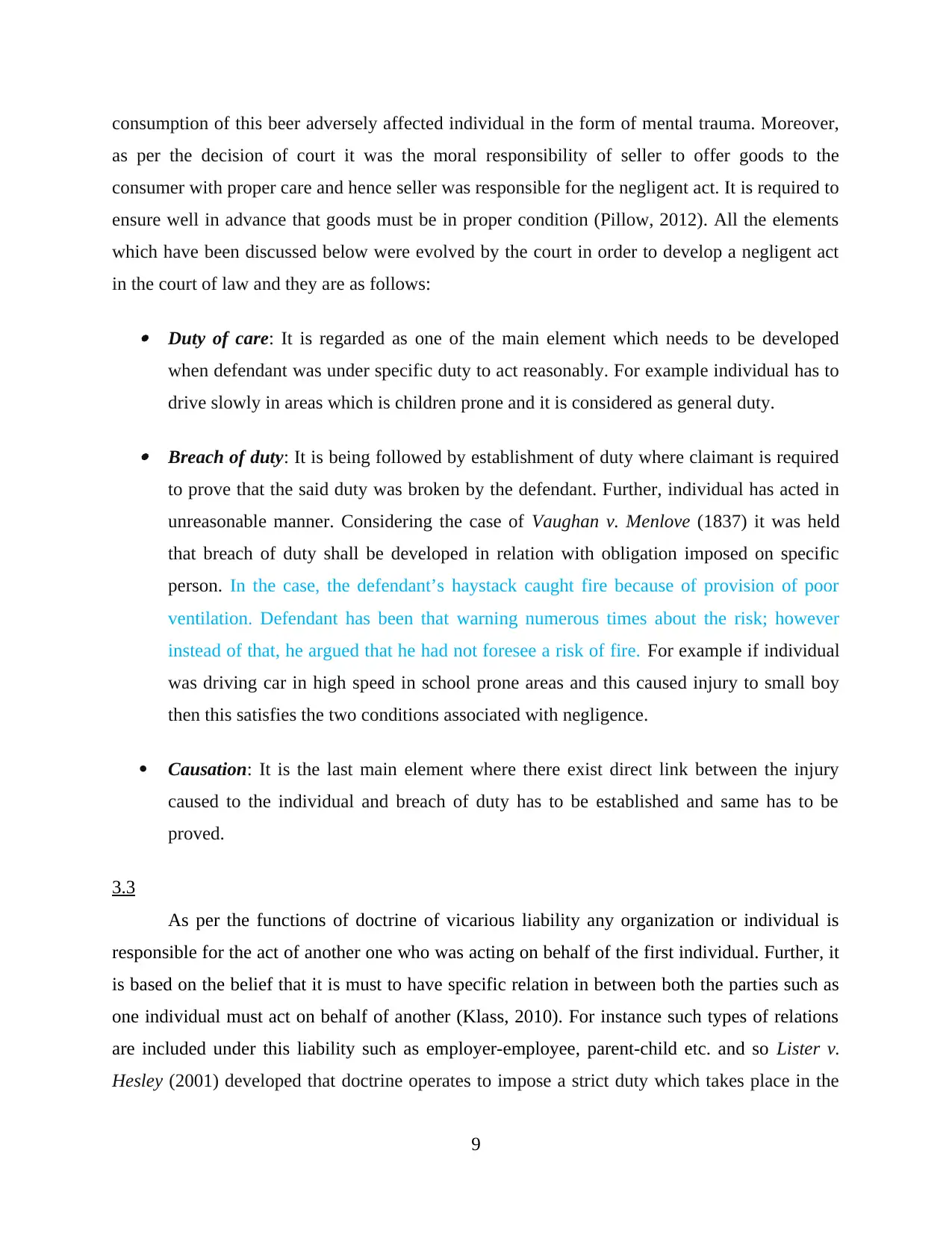
consumption of this beer adversely affected individual in the form of mental trauma. Moreover,
as per the decision of court it was the moral responsibility of seller to offer goods to the
consumer with proper care and hence seller was responsible for the negligent act. It is required to
ensure well in advance that goods must be in proper condition (Pillow, 2012). All the elements
which have been discussed below were evolved by the court in order to develop a negligent act
in the court of law and they are as follows:
Duty of care: It is regarded as one of the main element which needs to be developed
when defendant was under specific duty to act reasonably. For example individual has to
drive slowly in areas which is children prone and it is considered as general duty.
Breach of duty: It is being followed by establishment of duty where claimant is required
to prove that the said duty was broken by the defendant. Further, individual has acted in
unreasonable manner. Considering the case of Vaughan v. Menlove (1837) it was held
that breach of duty shall be developed in relation with obligation imposed on specific
person. In the case, the defendant’s haystack caught fire because of provision of poor
ventilation. Defendant has been that warning numerous times about the risk; however
instead of that, he argued that he had not foresee a risk of fire. For example if individual
was driving car in high speed in school prone areas and this caused injury to small boy
then this satisfies the two conditions associated with negligence.
Causation: It is the last main element where there exist direct link between the injury
caused to the individual and breach of duty has to be established and same has to be
proved.
3.3
As per the functions of doctrine of vicarious liability any organization or individual is
responsible for the act of another one who was acting on behalf of the first individual. Further, it
is based on the belief that it is must to have specific relation in between both the parties such as
one individual must act on behalf of another (Klass, 2010). For instance such types of relations
are included under this liability such as employer-employee, parent-child etc. and so Lister v.
Hesley (2001) developed that doctrine operates to impose a strict duty which takes place in the
9
as per the decision of court it was the moral responsibility of seller to offer goods to the
consumer with proper care and hence seller was responsible for the negligent act. It is required to
ensure well in advance that goods must be in proper condition (Pillow, 2012). All the elements
which have been discussed below were evolved by the court in order to develop a negligent act
in the court of law and they are as follows:
Duty of care: It is regarded as one of the main element which needs to be developed
when defendant was under specific duty to act reasonably. For example individual has to
drive slowly in areas which is children prone and it is considered as general duty.
Breach of duty: It is being followed by establishment of duty where claimant is required
to prove that the said duty was broken by the defendant. Further, individual has acted in
unreasonable manner. Considering the case of Vaughan v. Menlove (1837) it was held
that breach of duty shall be developed in relation with obligation imposed on specific
person. In the case, the defendant’s haystack caught fire because of provision of poor
ventilation. Defendant has been that warning numerous times about the risk; however
instead of that, he argued that he had not foresee a risk of fire. For example if individual
was driving car in high speed in school prone areas and this caused injury to small boy
then this satisfies the two conditions associated with negligence.
Causation: It is the last main element where there exist direct link between the injury
caused to the individual and breach of duty has to be established and same has to be
proved.
3.3
As per the functions of doctrine of vicarious liability any organization or individual is
responsible for the act of another one who was acting on behalf of the first individual. Further, it
is based on the belief that it is must to have specific relation in between both the parties such as
one individual must act on behalf of another (Klass, 2010). For instance such types of relations
are included under this liability such as employer-employee, parent-child etc. and so Lister v.
Hesley (2001) developed that doctrine operates to impose a strict duty which takes place in the
9
⊘ This is a preview!⊘
Do you want full access?
Subscribe today to unlock all pages.

Trusted by 1+ million students worldwide
1 out of 17
Related Documents
Your All-in-One AI-Powered Toolkit for Academic Success.
+13062052269
info@desklib.com
Available 24*7 on WhatsApp / Email
![[object Object]](/_next/static/media/star-bottom.7253800d.svg)
Unlock your academic potential
Copyright © 2020–2025 A2Z Services. All Rights Reserved. Developed and managed by ZUCOL.





